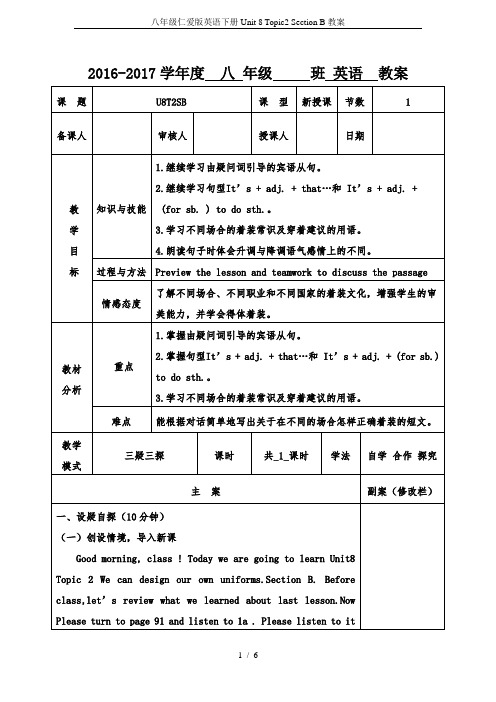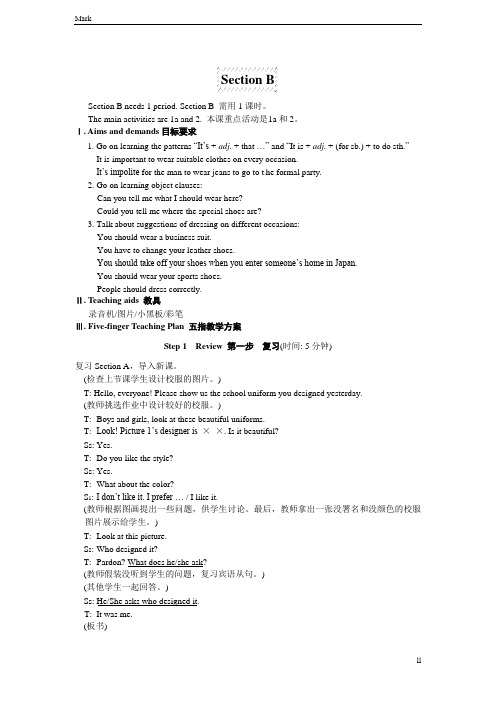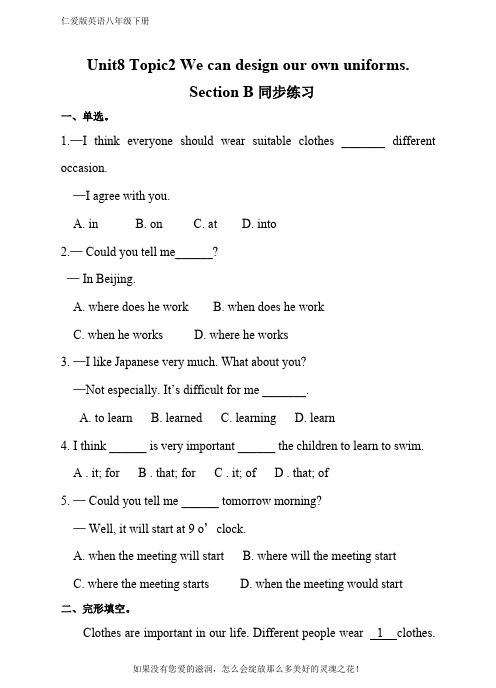【新】仁爱版八年级英语下册Unit8 Topic 2 SectionB优质课课件.ppt
- 格式:ppt
- 大小:1.18 MB
- 文档页数:18



Section BSection B needs 1 period. Section B 需用1课时。
The main activities are 1a and 2. 本课重点活动是1a和2。
Ⅰ. Aims and demands目标要求1. Go on learning the patterns “It’s + adj. + that …” and “It is + adj. + (for sb.) + to do sth.”It is important to wear suitable clothes on every occasion.It’s impolite for the man to wear jeans to go to t he formal party.2. Go on learning object clauses:Can you tell me what I should wear here?Could you tell me where the special shoes are?3. Talk about suggestions of dressing on different occasions:You should wear a business suit.You have to change your leather shoes.You should take off your shoes when you enter someone’s home in Japan.You should wear your sports shoes.People should dress correctly.Ⅱ. Teaching aids 教具录音机/图片/小黑板/彩笔Ⅲ. Five-finger Teaching Plan 五指教学方案Step 1 Review 第一步复习(时间: 5分钟)复习Section A,导入新课。

Unit8 Topic2 We can design our own uniforms.Section B同步练习一、单选。
1.—I think everyone should wear suitable clothes _______ different occasion.—I agree with you.A. inB. onC. atD. into2.— Could you tell me______?— In Beijing.A. where does he workB. when does he workC. when he worksD. where he works3. —I like Japanese very much. What about you?—Not especially. It’s difficult for me _______.A. to learnB. learnedC. learningD. learn4. I think ______ is very important ______ the children to learn to swim.A . it; forB . that; forC . it; ofD . that; of5. — Could you tell me ______ tomorrow morning?— Well, it will start at 9 o’clock.A. when the meeting will startB. where will the meeting startC. where the meeting startsD. when the meeting would start二、完形填空。
Clothes are important in our life. Different people wear 1 clothes.Now let's 2 some people talking about clothes.Hello, my name is Betty. I started working this year, so I'm able to get new clothes more often 3 before. There are different people in my working place every day. If someone sees me in 4 once, I don't like to go out in it again. I like to wear bright colors and always dress up when I go to parties. I buy all kinds of clothes and I try to follow the latest way of 5 .Hi, I'm Jack. I don't have much to say about clothes. Shopping 6 clothes isn't really the way of life I’m interested in. Since I'm still at college, I don't really mind 7 I wear. I have two jackets and I often wear 8 . I know little about the way of dressing. I don't like the serious look.My name is Alice. I'd like to say that my clothes have to be comfortable and make me 9 easy as soon as I put them on. Sometimes I buy clothes in some small markets—they're less expensive there. I go shopping for clothes about once a month. If I see 10 and fit for me, I would maybe go for it there.(1)A . the same B . different C . beautiful D . comfortable (2)A . listen to B . hear C . to listen to D . to hear(3)A . as B . like C . than D . long(4)A . something B . anything C . nothing D . everything(5)A . dress B . dressing C . dresses D . to dress(6)A . of B . in C . for D . on(7)A . what B . who C . where D . when(8)A . it B . them C . their D . they(9)A . to fee l B . feels C . feeling D . feel(10)A. something comfortable B. anything comfortableC. comfortable somethingD. comfortable anything三、阅读。

Unit8 Topic2 SectionB 参考教案Ⅰ. Material analysis本节课建议教师用1课时上完.主要活动为Section B 的1a和2.本节课的新课内容由谈论不同场合的着装常识展开,引导学生继续学习由疑问词引导的宾语从句和"It’s + adj. + that…"以与"It’s + adj. + <for sb. > to do sth."的用法.着装艺术是学生非常感兴趣和关心的话题,教师应在课前精心设计本节活动内容,准备一些相关的知识,让学生充分意识到穿着得体的重要性.Ⅱ. Teaching aimsKnowledge aims:1. 继续学习由疑问词引导的宾语从句.2. 继续学习句型It’s + adj. + that…和It’s + adj. + <for sb. > to do sth..3. 学习不同场合的着装常识与穿着建议的用语.4. 朗读句子时体会升调与降调语气感情上的不同.Skill aims:1. 能听懂接近正常语速、涉与着装艺术的语段,获取主要信息.2. 能就着装艺术的话题进行简单的交谈.3. 能从简单的文章中找出有关信息,理解大意.4. 能根据对话简单地写出关于着装艺术的短文.Emotional aims:1. 充分意识到穿着得体的重要性.2. 能在小组活动中积极与他人合作,相互帮助,共同完成学习任务.Ⅲ. The key points and difficult pointsKey points:1. 继续学习由疑问词引导的宾语从句.2. 继续学习句型It’s + adj. + that…和It’s + adj. + <for sb. > to do sth..3. 学习不同场合的着装常识与穿着建议的用语.Difficult points:1. 能根据对话简单地写出关于在不同的场合怎样正确着装的短文.2. 朗读句子时体会升调与降调语气感情上的不同.Ⅳ. Learning strategies1. 朗读时用降调表示命令的语气,用升调表示更有礼貌的请求.2. 体会句子中运用特定的句式进行某一内容的强调.3. 注意借助音像资料丰富自己的学习.Ⅴ. Teaching aidsputer multimedia projector; the videos about the activities in different occasions: having a meeting, having a party, doing sports, having a class and so on; the picture of attendants; The teacher should wear a suit for the class.Ⅵ. Teaching proceduresIntroduction〔8 minutes〕1. Greet students and make them ready for learning.2. The teacher lets students play the game "Pardon?" to review the usage of object clauses. Let them play the game in groups of three. They may change their roles one another.A: <speak out a wh-question>B: Can you tell me what A asks?C: She / He asks …3. The teacher lets students show the pictures of school uniforms designed by themselves. They can add the colors, the materials, and even the reasons of designing.4. The teacher lets students read the passage about the importance of some uniforms which they finished before class.5. The teacher evaluates their work and leads to new lesson by playing the videos about the activities on different occasions: having a meeting, having a party, doing sports, having a class and so on: It’s important to wear suitable clothes. I must wear a suit when I have the class, while you must wear school uniforms. We should wear different clothes correctly on different occasions.Presentation<10 minutes>1. The teacher lets students look at Picture 1 of 1a and lets them discuss what the man should wear on this kind of occasion.2. The teacher plays the first flash of 1a and lets the students watch and check theirdiscussion. Let them know about the meaning of gatekeeper by showing gate + keeper →gatekeeper. Teach the word suit by pointing at the teacher’s clothes.3. The teacher lets students learn different dressings on the other three occasions in the same way. Teach the new words after watching and checking. Teach attendant by show the pictures of attendants on the screen. Teach take off by putting on a hat and then taking it off. Teach knee by pointing at the knee of himself or herself. Explain the meanings of enter.4. The teacher plays the flash of the conversation between Jane and Maria. Let students watch it and find out the opinions of them.5. The teacher asks two students to tell the answers. Explain the meanings of occasion and correctly to them.Consolidation<10 minutes>1. The teacher plays the recording sentence by sentence.2. The teacher plays the recording without stopping.3. The teacher asks students to read the sentences in 1b and mark T <True> or F <False>.4. The teacher asks two students to tell the answers.5. The teacher lets students read the passage in 1c. Let them understand the meaning of this passage, and try pleting the passage.6. The teacher asks students to read the conversation of 1a and lets them check the blanks they have filled.7. The teacher asks two students to tell the answers.8. The teacher lets students read 1a and find out the sentences about object clauses with wh-questions and the sentences giving suggestions.9. The teacher asks two students to tell the answers. Write them on the blackboard. Stress the order of object clauses with wh-questions.10. The teacher lets students read 1a in roles and perform short plays in pairs. <Each pair may just play one short play.>Practice<10 minutes>1. The teacher lets students read 1a and find out the sentences of It’s + adj. + <forsb. > to do sth.2. The teacher asks two s tudents to tell the answers: It’s important to wear suitable clothes on every occasion. Guide students to change it to It’s + adj. + that …<It’s important that we wear suitable clothes on every occasion.>3. The teacher lets studentsobserve the pictures of 2 and read the given words, the phrases and the example.4. The teacher asks students to make sentences with the structures It’s + adj. + <for sb. > to do sth. and It’s + adj. + that …, using the given words and phrases according to the pictures.5. The teacher asks four students from different groups to write down the sentences on the blackboard. Student A writes the sentence according to Picture 1…6. The teacher asks one or two students to check the sentences on the blackboard. Give them a hand if necessary.7. The teacher plays the recording of 3 after they read the sentences by themselves.Let students listen and check their intonation.8. The eacher plays the recording of 3 again, and lets the students listen and try to imitate.Production<7 minutes>1. The teacher asks the students to discuss in groups about how to dress correctly on different occasions. Teacher had better help them set certain situations, such as going to a formal party, going to the movies or going out to do some exercise.Help them design a table and ask them to finish the table after discussing.Activities What to weargo to a partygo to the moviesdo exercise2. The teacher asks students to write a passage according to the result of the discussion above. Then report i t to the class. Remind them to use the structures: It’s important …, You should/ had better/ have to ….3. The teacher shows the summary of this section to the students.4. The teacher assigns homework:<1> Review the summary after class.<2> Collect some information about how to dress correctly on different occasions.<3> Make five sentences with the following structures:It’s + adj. + that … or It’s + adj. + <for sb.> to do sth.Teaching ReflectionTeacher may let students prepare some clothes before class if possible, they will do better in the performances of the four brief conversations. The teacher can set more certain situations and let the students discuss the suitable clothes they should wear in those occasions.Ⅶ. Blackboard designUnit 8 Our ClothesTopic 2 We can design our own uniforms.Section B1. gate + keeper →gatekeeper2. take off →put on3. correct →correctly4. It’s important to wear suitable clothes on every occasion. →It’s important that we wear suitable clothes on every occasion.Object clauses with wh-questions:Can you tell me what I should wear here?Could you tell me where the special shoes are?Sentences giving suggestions:You should wear a business suit.You have to change your leather shoes.You should take off your shoe s when you enter someone’s home in Japan.You should wear your sports clothes.People should dress correctly.。
